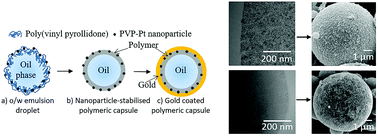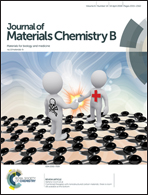A two-step synthesis for preparing metal microcapsules with a biodegradable polymer substrate†
Abstract
Metal microcapsules have recently received attention and are being developed as improved carrier materials when compared to polymer microcapsules. In this work we have developed a novel, simplified method by which polymeric microcapsules can be synthesised using a combination of poly(vinyl pyrrolidone)-stabilised platinum nanoparticles (PVP-Pt) and poly(vinyl pyrrolidone) (PVP) as stabilisers, to allow for a secondary metal shell to be grown. We investigate the relationship between the molar ratio of reducing agent to platinum salt and the size of the resulting NPs and seek to develop further fundamental understanding of the factors governing the secondary metal shell thickness and quality, to allow production of cost-effective metal microcapsules without sacrificing core retention efficiency. We found that the size of the nanoparticles had no significant effect on secondary shell thickness, but did affect the quality of the resulting gold shells. Gold salt concentration was found to be a limiting factor in the electroless deposition of the metal shell. In this work, we have successfully produced PLGA microcapsules with more cost-effective gold shells, as thin as 56 ± 13 nm and capable of complete core retention of volatile actives.



 Please wait while we load your content...
Please wait while we load your content...